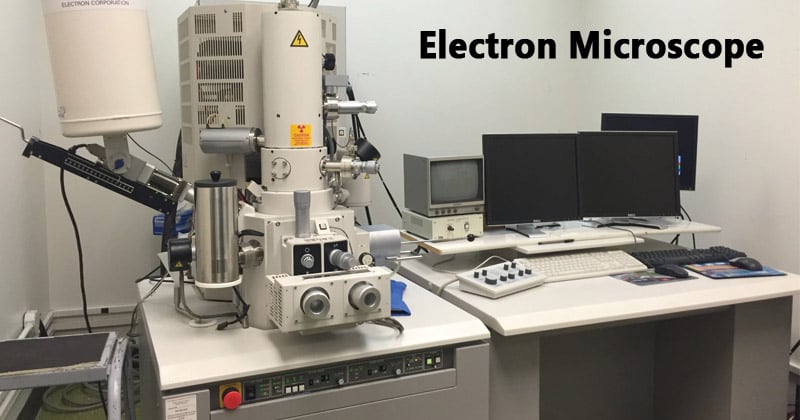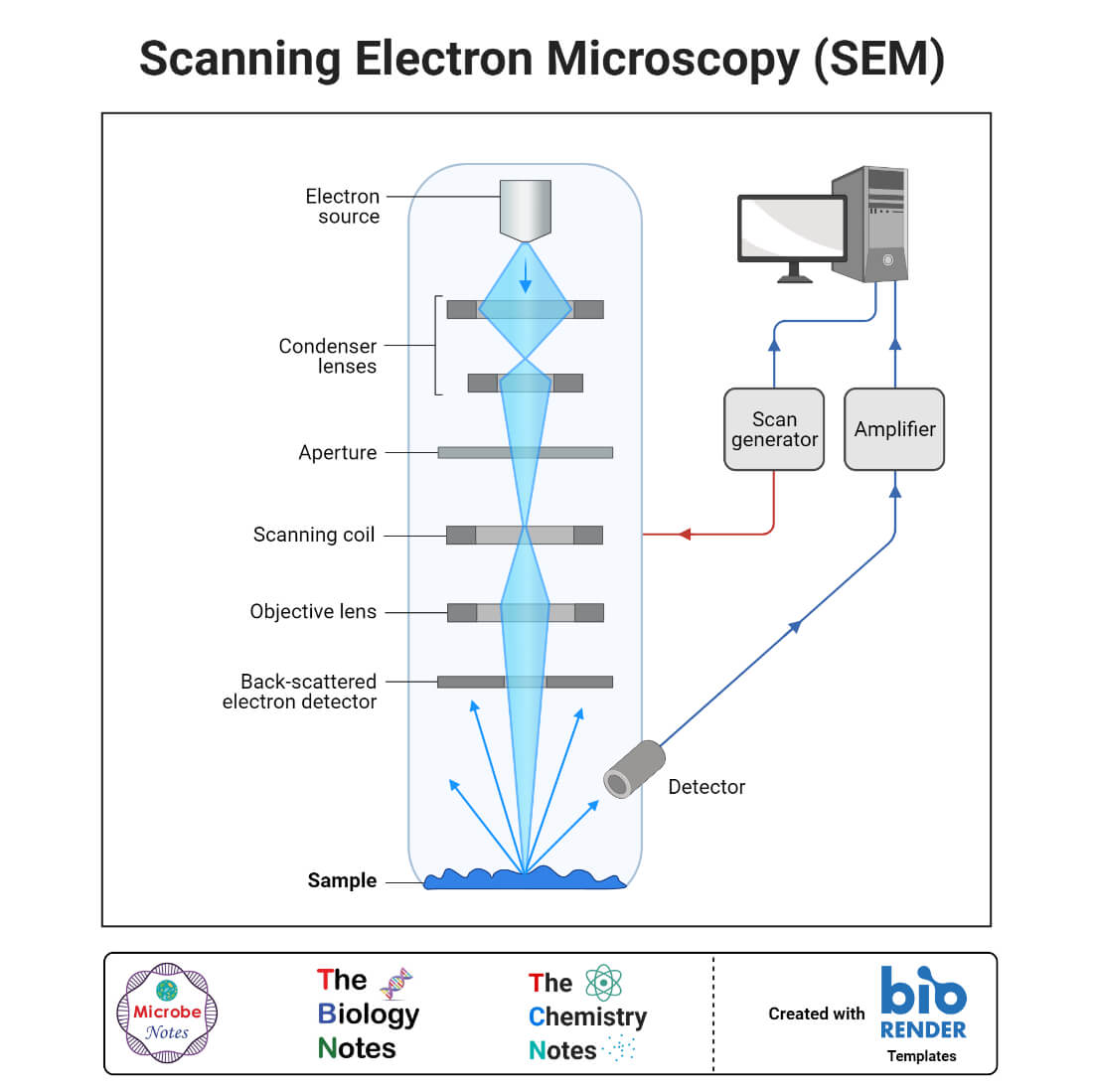An electron microscope is a microscope that uses a beam of accelerated electrons as a source of illumination. It is a special type of microscope having a high resolution of images, able to magnify objects in nanometres, which are formed by controlled use of electrons in a vacuum captured on a phosphorescent screen.
Ernst Ruska (1906-1988), a German engineer and academic professor, built the first Electron Microscope in 1931, and the same principles behind his prototype still govern modern EMs.

Interesting Science Videos
Working Principle of Electron Microscope
Electron microscopes use signals arising from the interaction of an electron beam with the sample to obtain information about structure, morphology, and composition.
- The electron gun generates electrons.
- Two sets of condenser lenses focus the electron beam on the specimen and then into a thin tight beam.
- To move electrons down the column, an accelerating voltage (mostly between 100 kV-1000 kV) is applied between the tungsten filament and anode.
- The specimen to be examined is made extremely thin, at least 200 times thinner than those used in the optical microscope. Ultra-thin sections of 20-100 nm are cut which is already placed on the specimen holder.
- The electronic beam passes through the specimen and electrons are scattered depending upon the thickness or refractive index of different parts of the specimen.
- The denser regions in the specimen scatter more electrons and therefore appear darker in the image since fewer electrons strike that area of the screen. In contrast, transparent regions are brighter.
- The electron beam coming out of the specimen passes to the objective lens, which has high power and forms the intermediate magnified image.
- The ocular lenses then produce the final further magnified image.
Types of Electron microscope
There are two types of electron microscopes, with different operating styles:
1. Transmission Electron Microscope (TEM)

- The transmission electron microscope is used to view thin specimens through which electrons can pass generating a projection image.
- The TEM is analogous in many ways to the conventional (compound) light microscope.
- TEM is used, among other things, to image the interior of cells (in thin sections), the structure of protein molecules (contrasted by metal shadowing), the organization of molecules in viruses and cytoskeletal filaments (prepared by the negative staining technique), and the arrangement of protein molecules in cell membranes (by freeze-fracture).
2. Scanning Electron Microscope (SEM)

- Conventional scanning electron microscopy depends on the emission of secondary electrons from the surface of a specimen.
- Because of its great depth of focus, a scanning electron microscope is the EM analog of a stereo light microscope.
- It provides detailed images of the surfaces of cells and whole organisms that are not possible by TEM. It can also be used for particle counting and size determination, and for process control.
- It is termed a scanning electron microscope because the image is formed by scanning a focused electron beam onto the surface of the specimen in a raster pattern.
Parts of Electron Microscope
Electron Microscope is in the form of a tall vacuum column that is vertically mounted. It has the following components:
1. Electron gun
- The electron gun is a heated tungsten filament, which generates electrons.
2. Electromagnetic lenses
- The condenser lens focuses the electron beam on the specimen. A second condenser lens forms the electrons into a thin tight beam.
- The electron beam coming out of the specimen passes down the second of magnetic coils called the objective lens, which has high power and forms the intermediate magnified image.
- The third set of magnetic lenses called projector (ocular) lenses produce the final further magnified image.
- Each of these lenses acts as an image magnifier all the while maintaining an incredible level of detail and resolution.
3. Specimen Holder
- The specimen holder is an extremely thin film of carbon or collodion held by a metal grid.
4. Image viewing and Recording System
- The final image is projected on a fluorescent screen.
- Below the fluorescent screen is a camera for recording the image.
Applications of Electron microscope
- Electron microscopes are used to investigate the ultrastructure of a wide range of biological and inorganic specimens including microorganisms, cells, large molecules, biopsy samples, metals, and crystals.
- Industrially, electron microscopes are often used for quality control and failure analysis.
- Modern electron microscopes produce electron micrographs using specialized digital cameras and frame grabbers to capture the images.
- The science of microbiology owes its development to the electron microscope. The study of microorganisms like bacteria, virus, and other pathogens have made the treatment of diseases very effective.
Advantages of Electron microscope
- Very high magnification
- Incredibly high resolution
- Material rarely distorted by preparation
- It is possible to investigate a greater depth of field
- Diverse applications
Limitations of Electron microscope
- The live specimen cannot be observed.
- As the penetration power of the electron beam is very low, the object should be ultra-thin. For this, the specimen is dried and cut into ultra-thin sections before observation.
- As the EM works in a vacuum, the specimen should be completely dry.
- Expensive to build and maintain
- Requiring researcher training
- Image artifacts resulting from specimen preparation.
- This type of microscope is large, cumbersome extremely sensitive to vibration and external magnetic fields.
References
- http://www.biologydiscussion.com/microscope/electron-microscope/electron-microscope-principle-components-specimen-preparation-and-uses/16595
- https://en.wikipedia.org/wiki/Electron_microscope
- https://www.wikilectures.eu/w/Electron_microscopy/principle
- http://www.yourarticlelibrary.com/microeconomics/working-principle-of-a-electron-microscopes-with-diagram/26479
- https://www.slideshare.net/gangahuvin/electron-microscopy-16995175
- https://www.umassmed.edu/cemf/whatisem/
- https://www.microscopemaster.com/electron-microscope.html
- https://getrevising.co.uk/grids/electron_microscopes_2

Thank u so much .
This piece cleared all of my confusions.
it is really helpful, thanks
Very helpful 😊
Thank you 🙏
I have cleared my all confusion 😊
Good
Very useful piece, really appreciate it. Thank you.
😎
What a wonderful notes I really appreciate it
Thanks for the support. We indeed appreciated your work.
Awesome explanations… Thanks for the nice work you pple are doing… 👋👍
Thanks and I appreciate for your contribution towards me, God bless and give more wisdom
The article is a very useful tool for new students in science and engineering field.very explicit and details.
Thanks for the good work.
It’s awesome explanation given on each topics…. Very very excellent explanations… Please do continue this excellence on every topics… Superb..
Because they have to be cut into ultra thin pieces plus specimens have to be completely dry.
Ok what are the reason that we cannot used electron microscope in living things
Bcs of radiation